Part of my work as a systems coach is documenting my conversations with leaders and teachers around their goals for building more equitable outcomes for students.
We use a Google Sheet to capture notes and categorize the part of the project the interaction falls under. I understand the administrative requirements. I also appreciate creating a historical document so coaches after me can follow the conversation I have already had with schools and districts.
However, the limit of this basic tool and process is that I don’t go back over these notes much to understand where we’ve come from and where we want to go. A core function of any type of documentation tool as a coach is that it supports and informs our practice with the goal of improving our interactions with schools and educators.
Introducing the Coach’s Notebook
What I present here is a process and a tool: the coach’s notebook. It offers a responsive and supportive way to capture and organize the actions and commitments of your coaching practice.
This notebook can be digital or print. I prefer print, because it is a less distracting space when I am working with a client or dedicating time for weekly reflection. There are no apps to open or emails to check. The nature of analog notebooks provides the healthy constraints I need to focus.
In this podcast, Stephanie Affinito offers an explanation of the different types of “notebooking” one can engage in, both personally and professionally.
- At one end is structured notebooking. Productive writing, such as bullet journaling, is an example. A coach documents their actions and possibly tracks their habits to ensure projects such as inquiry cycles are completed.
- On the other end is unstructured notebooking. Reflective writing and freewriting fall into this category. It supports one’s self-awareness and sense of being. It’s an opportunity to hit Pause on all the doing and take time to understand the outcomes of our actions.
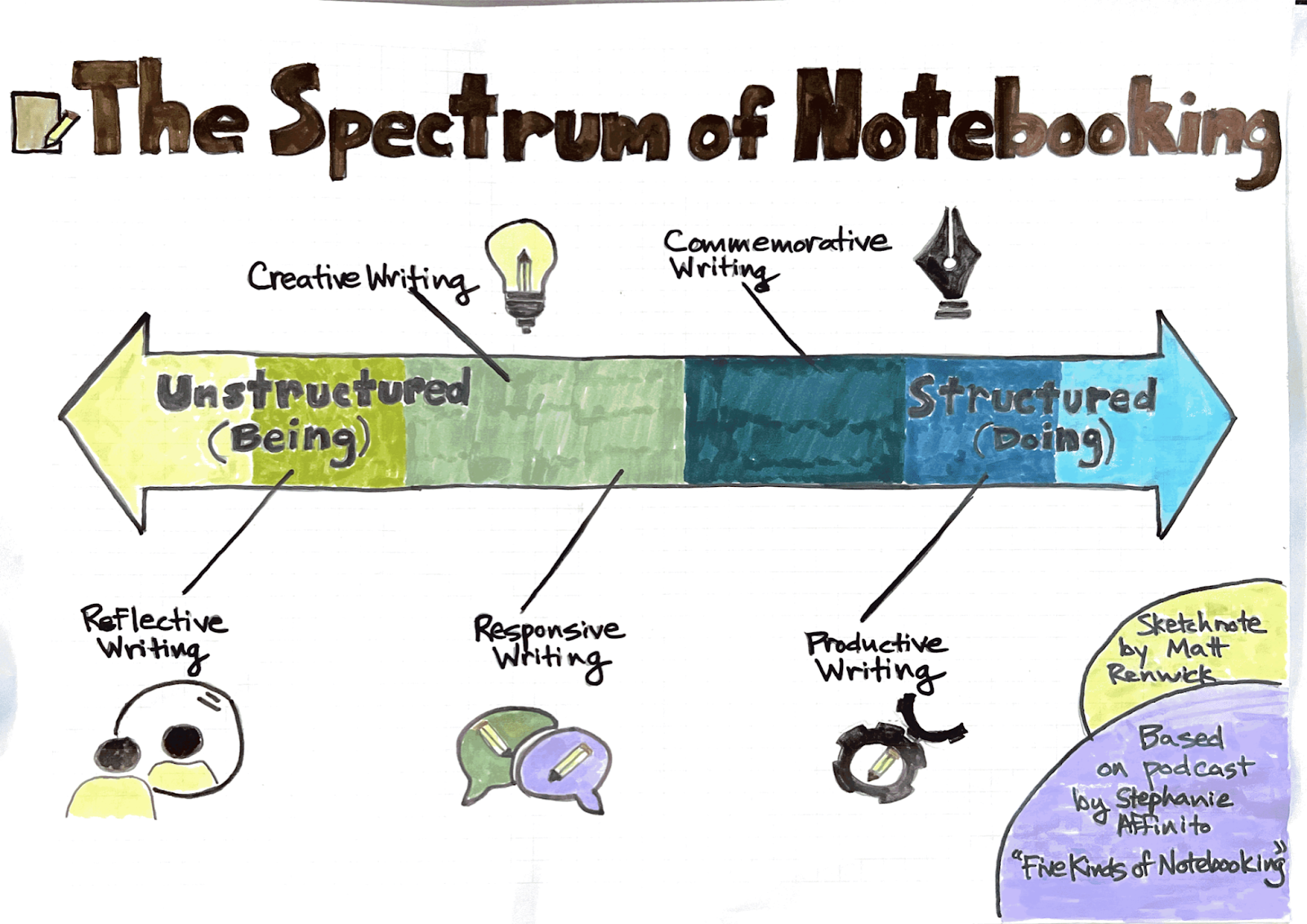
In this article, I focus on structured journaling as the primary approach to using a notebook to support my coaching practice. Reflective writing/freewriting is a component within this tool to cultivate presence alongside productivity.
Getting Started: The Daily Log and Next-Actions List
I recently had a coaching conversation with a special education teacher, Ronnie.
Ronnie was working with a student, Holden, for extended school year support during the summer. The goal, in addition to maintaining his literacy skills, was to improve Holden’s attitude toward reading and writing. He had a history of failure in his school career. Ronnie wanted to turn that around while engaging in effective literacy experiences.
As I listened to Ronnie, I started an entry in my notebook.
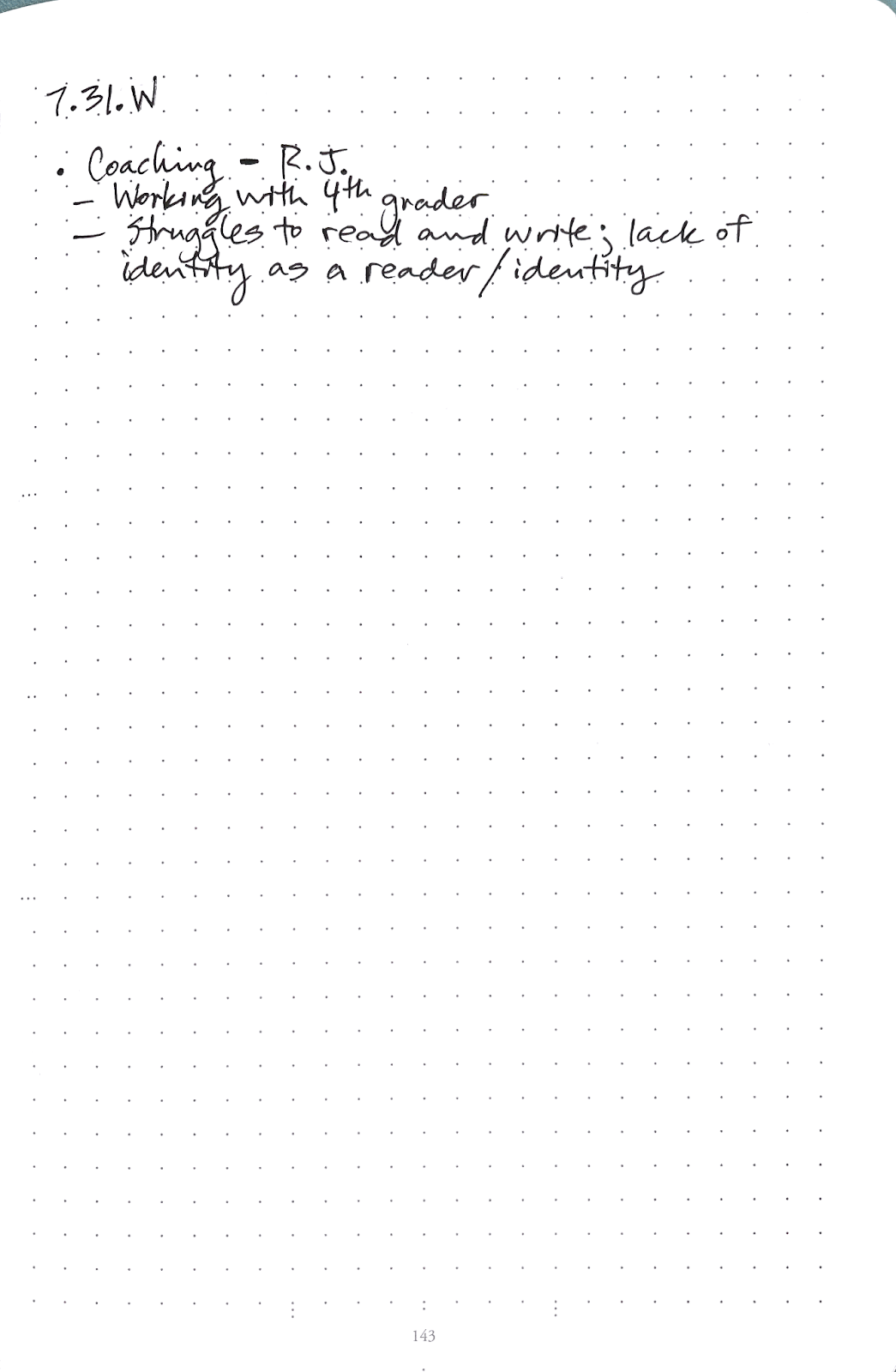
This note is part of my daily log. This log is the structured form of notebooking. Each log is headlined with the month, date, and day of the week (July 31, Wednesday). Each activity, or task, is designated with a dot. Dashes convey notes within the activity/task.
As Ronnie and I continued to talk, I captured what I heard with brief notes. “Holden struggles partly because of attention challenges. He loves video games, but I haven’t found a way to leverage that interest within reading and writing.” I wrote down just enough information to remember later on what was shared.
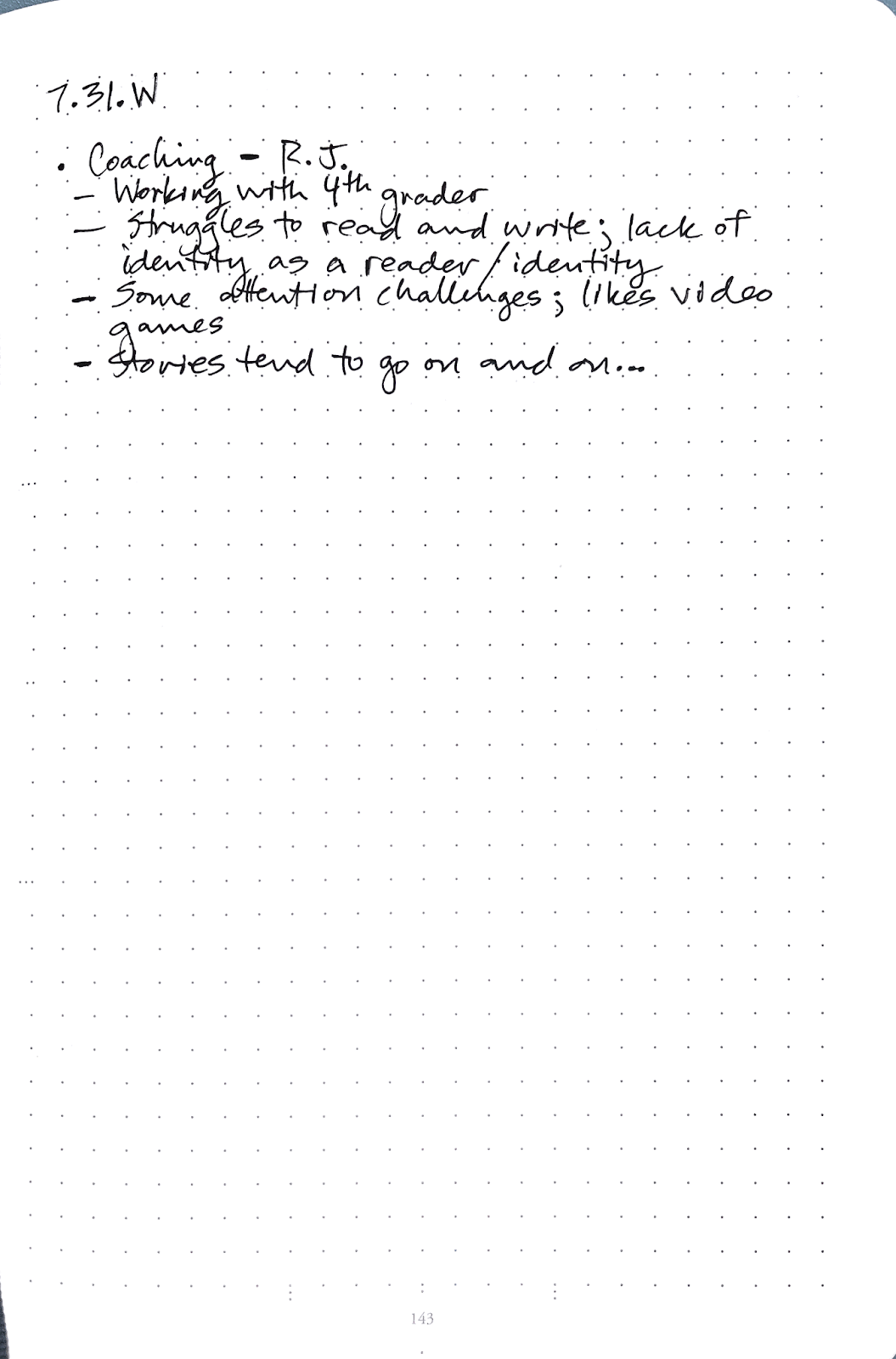
When I write while coaching, it focuses my attention on what the client is saying. Writing on paper also helps me notice patterns in what is shared. I can see the big picture of our conversation.
For example, while pausing to reread what I wrote down, I posed a question to Ronnie: “What are your thoughts on using Holden’s writing as a pathway to help increase his confidence as a reader and improve his reading?”
“I know, you have mentioned that before…”
Sensing Ronnie might be feeling stuck, I asked if I could put an idea on the table. “Are you familiar with the Pixar story map?” I pulled up a visual from the internet that the famed animation studio uses as a framework for organizing their screenplays.
The Pixar Story Map: Six Steps
- Once upon a time…
- Every day…
- Until one day…
- Because of that…
- Because of that…
- Until one day…
“It’s a scaffold that Holden might be open to using to organize his rambling stories.” With this scaffold, Ronnie was feeling more confident about trying this approach to outlining.
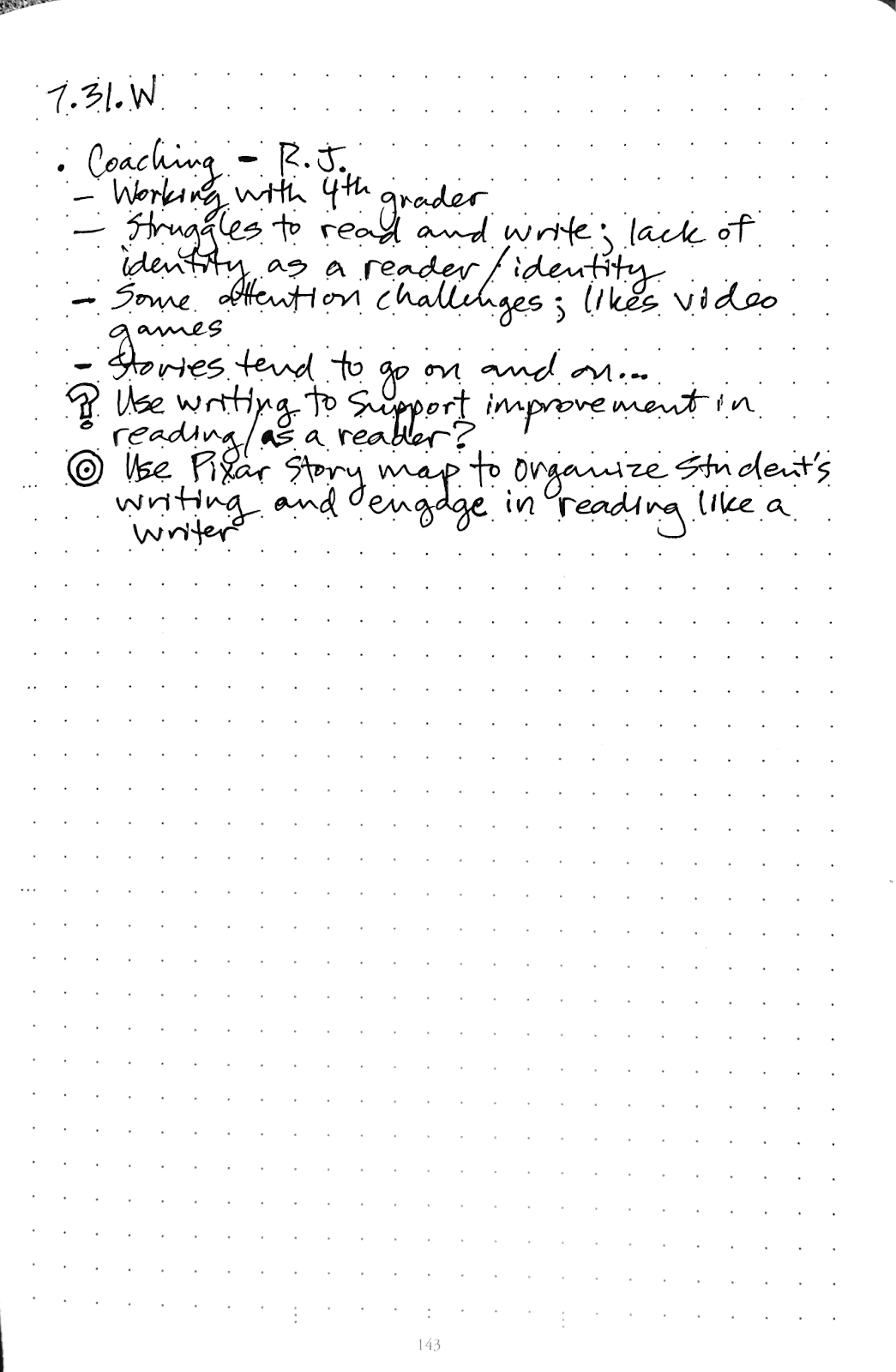
As a visual key, I used a question mark for my initial inquiry and a target to denote the idea Ronnie would try with Holden.
My daily log includes other activities. For example, on July 31 I also needed to drop off some literacy training guides and participate in a technical assistance network meeting.
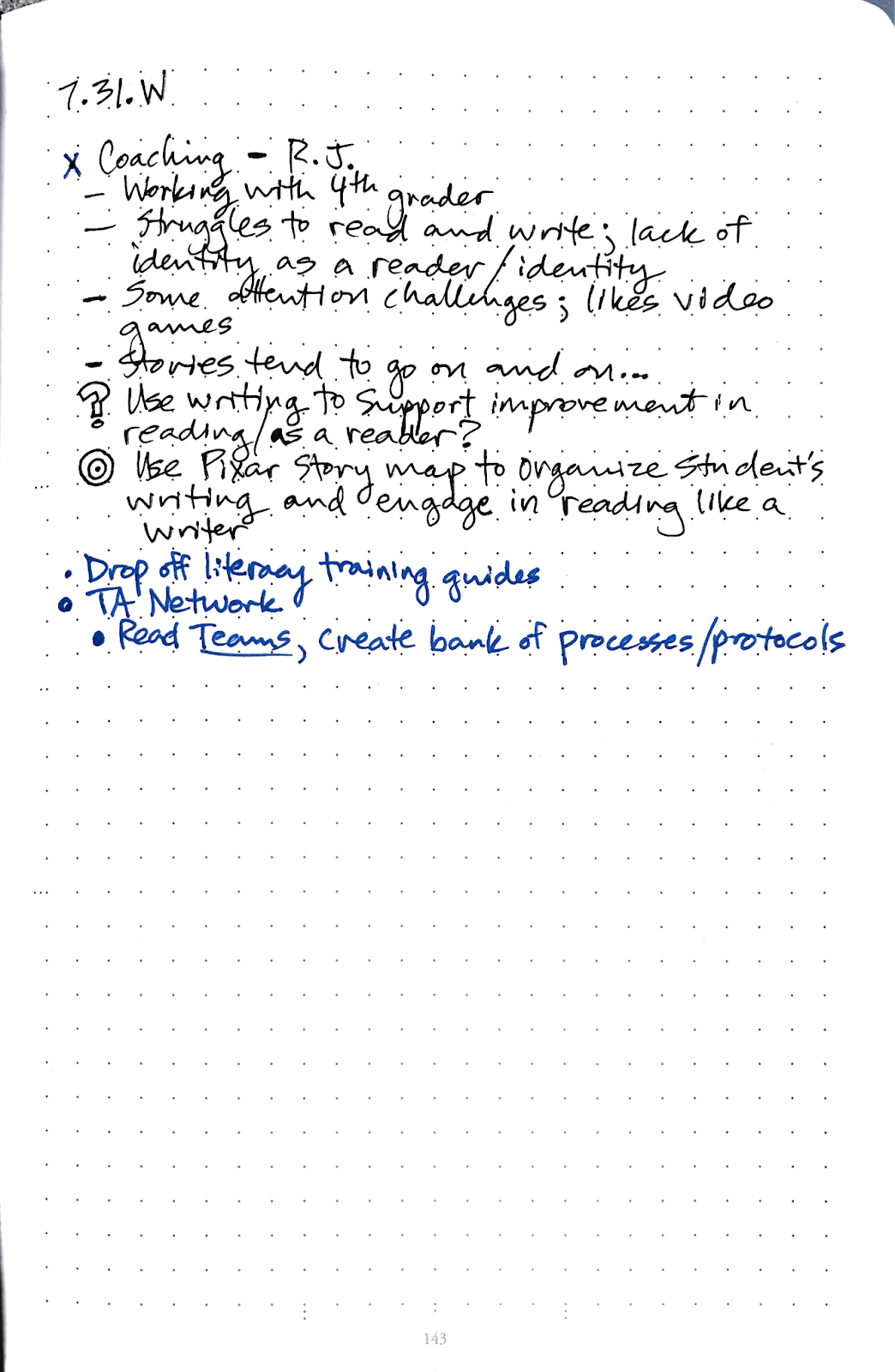
When a task is complete, I draw an X through the dot. To organize the tasks that need my follow-up, such as checking in with Ronnie to see how the story map strategy went, I have a list titled “Next Actions” at the beginning of my notebook.
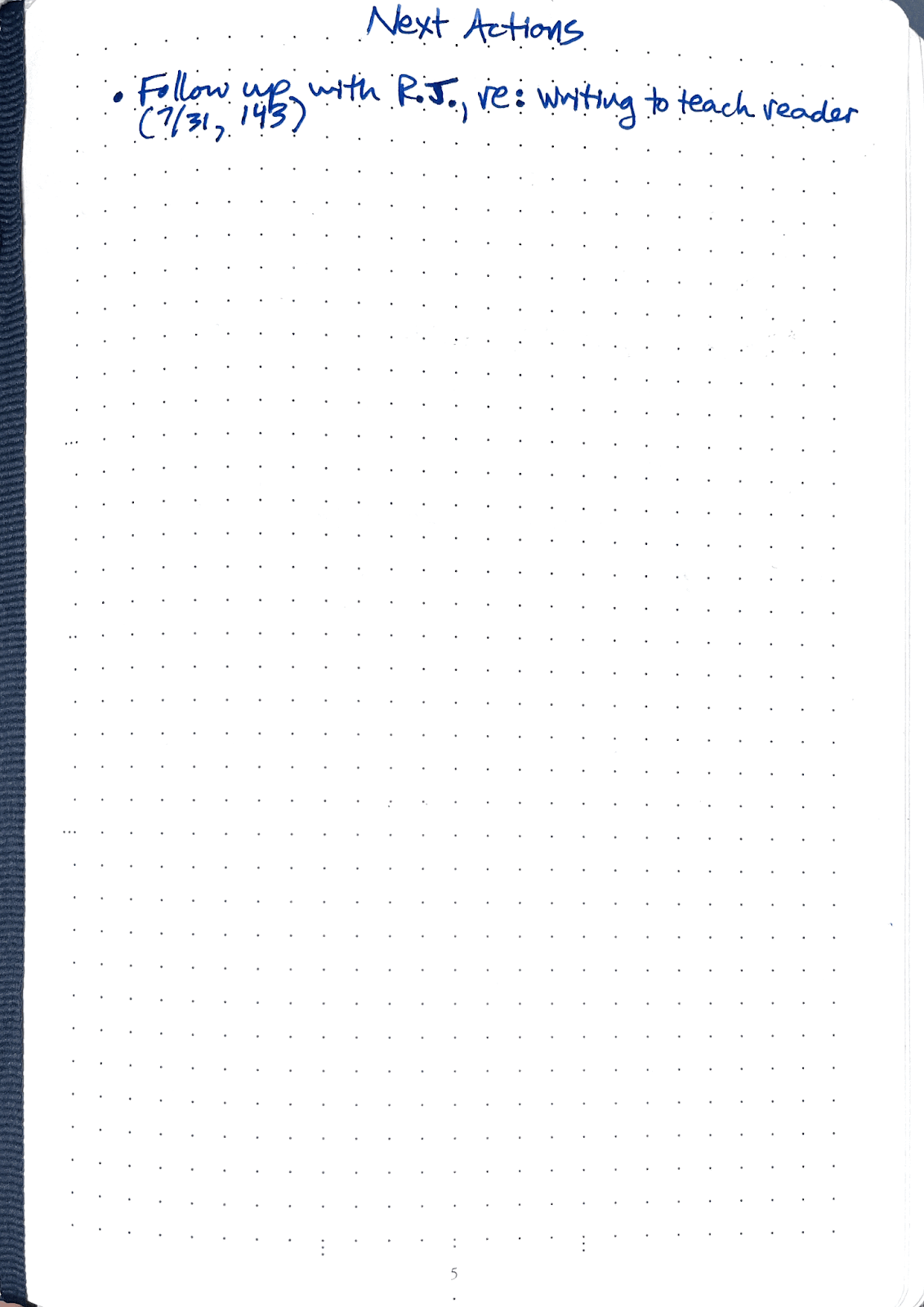
This list organizes all of the next actions I need to take. I include the date that I added the task along with the page number in my notebook where I can find my notes on this task.
Day 2: Following Up with Ronnie
I opened up my email to find a message from Ronnie in my inbox.
“Here is his story so far. I thought you would get a kick out of his style.”
Holden’s story was attached.
I go to Arkham Arcade seven days a week to eat tacos and play video games. One day, I was in an escape room when someone else started chasing me. As I was trying to escape, I ran through a wall and into a strange place…
I noticed the lead that created the setting, the transitions, and the immediate introduction of the conflict. When I read Holden’s ending, I cringed a bit.
I pried open the elevator doors and waited for the next chance to jump onto the floor. Then I woke up in my room. The next voice I heard was my mom saying, “It’s time for breakfast.”
Following up with Ronnie later that day, I asked for her thoughts about the “it was all just a dream” ending.
“Oh, I know. I was kind of disappointed. But I was also happy that Holden finished his story. It’s a win for him.”
I nodded. “And for you! This success will lead to future successes, thanks to your approach. Did the Pixar story map help?”
Ronnie noted that it did provide some healthy constraints. “He did resist it at first. But when I applied the framework to some familiar stories, he saw the benefits.”
After this conversation, I added my notes to that day’s daily log on the next page in my coach’s notebook.
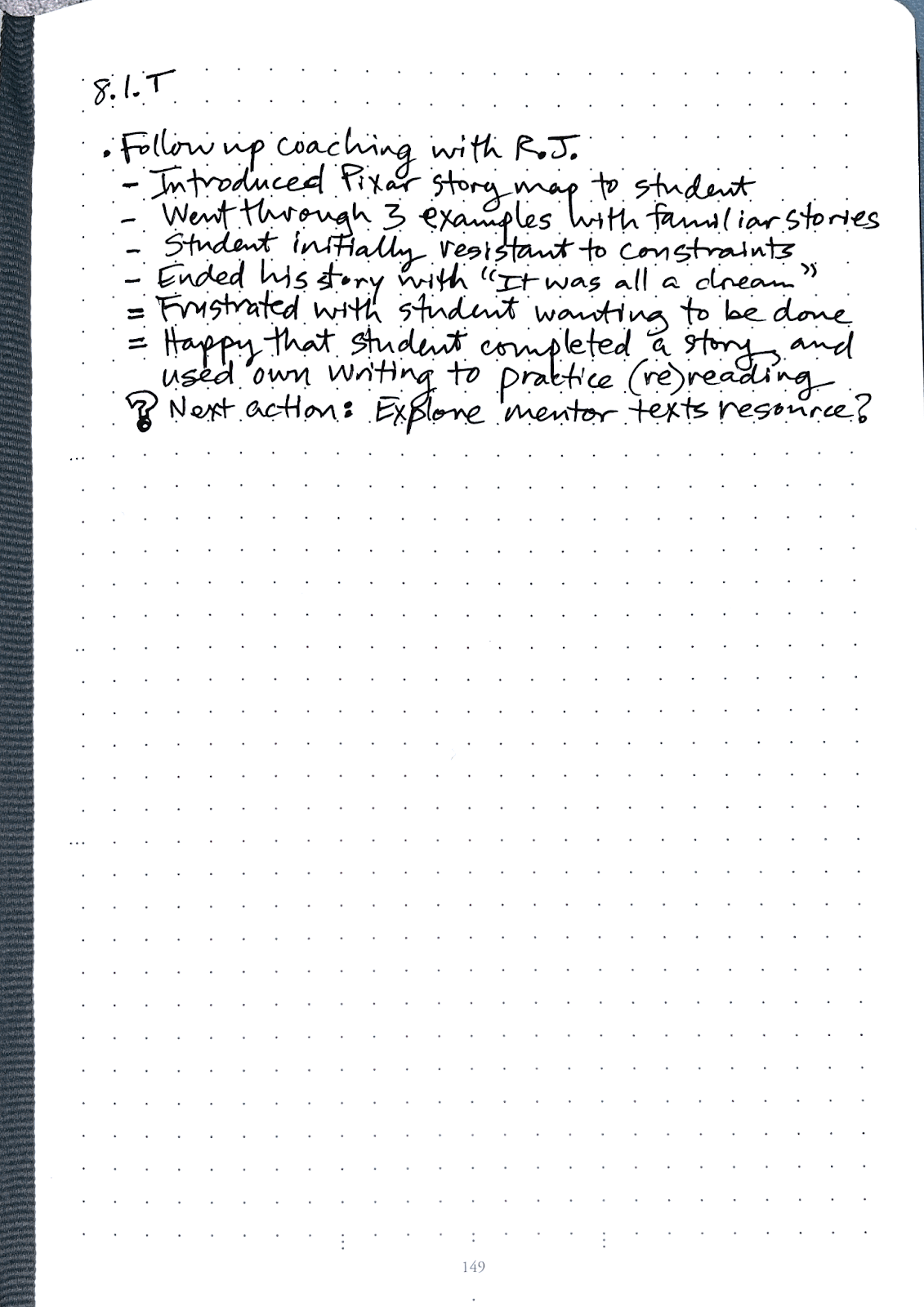
As I jotted notes, a question surfaced: Would it be worth exploring mentor texts as a next coaching cycle with Ronnie? That question led to another insight: If endings are a challenge for Holden, are other students and classrooms struggling with this same part of writing?
I turned one of the dashes into a plus to denote some related reflective writing.
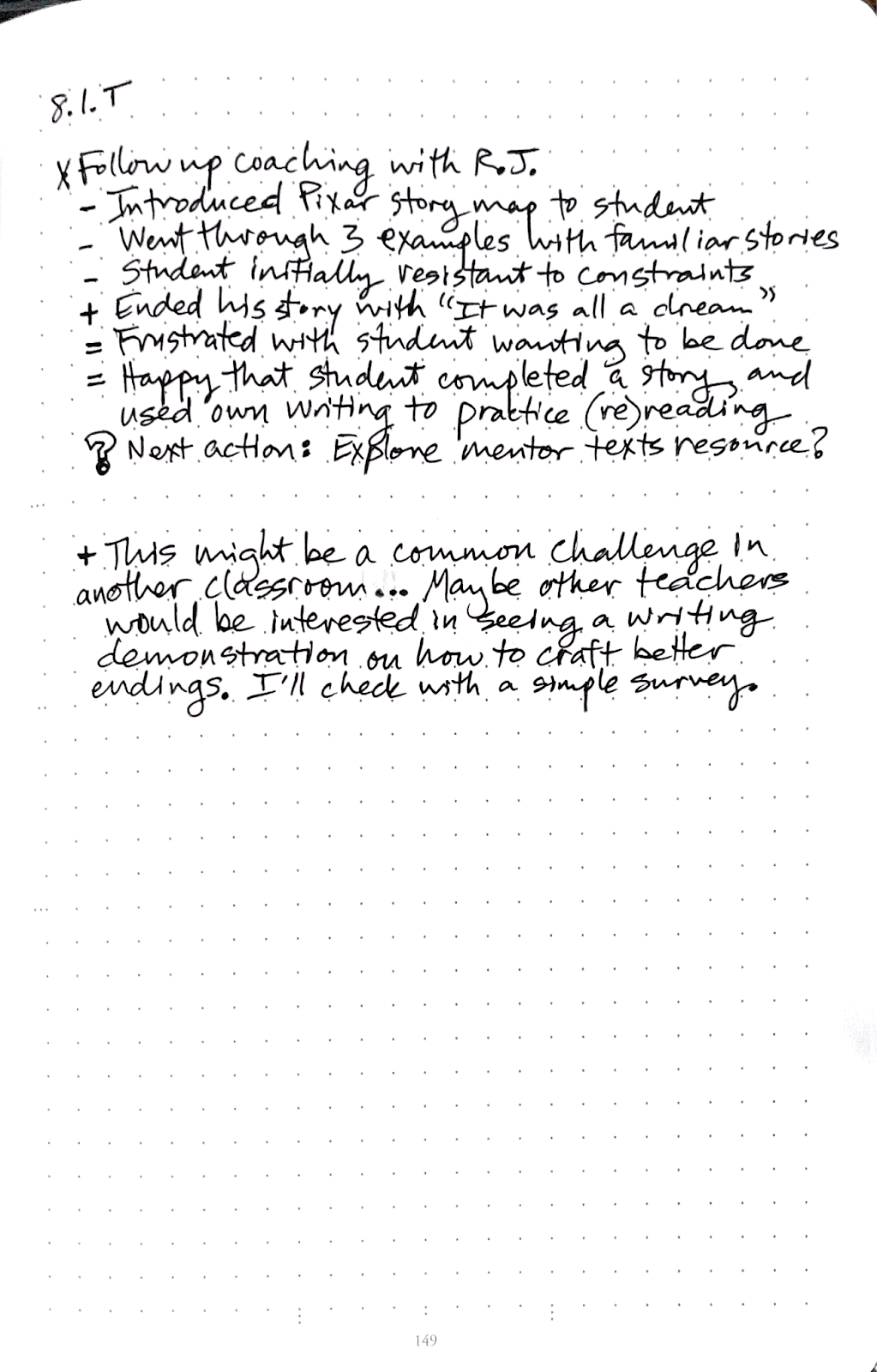
Expanding on the structured approach of my productive writing with the unstructured nature of reflective writing helped me arrive at a new next action.
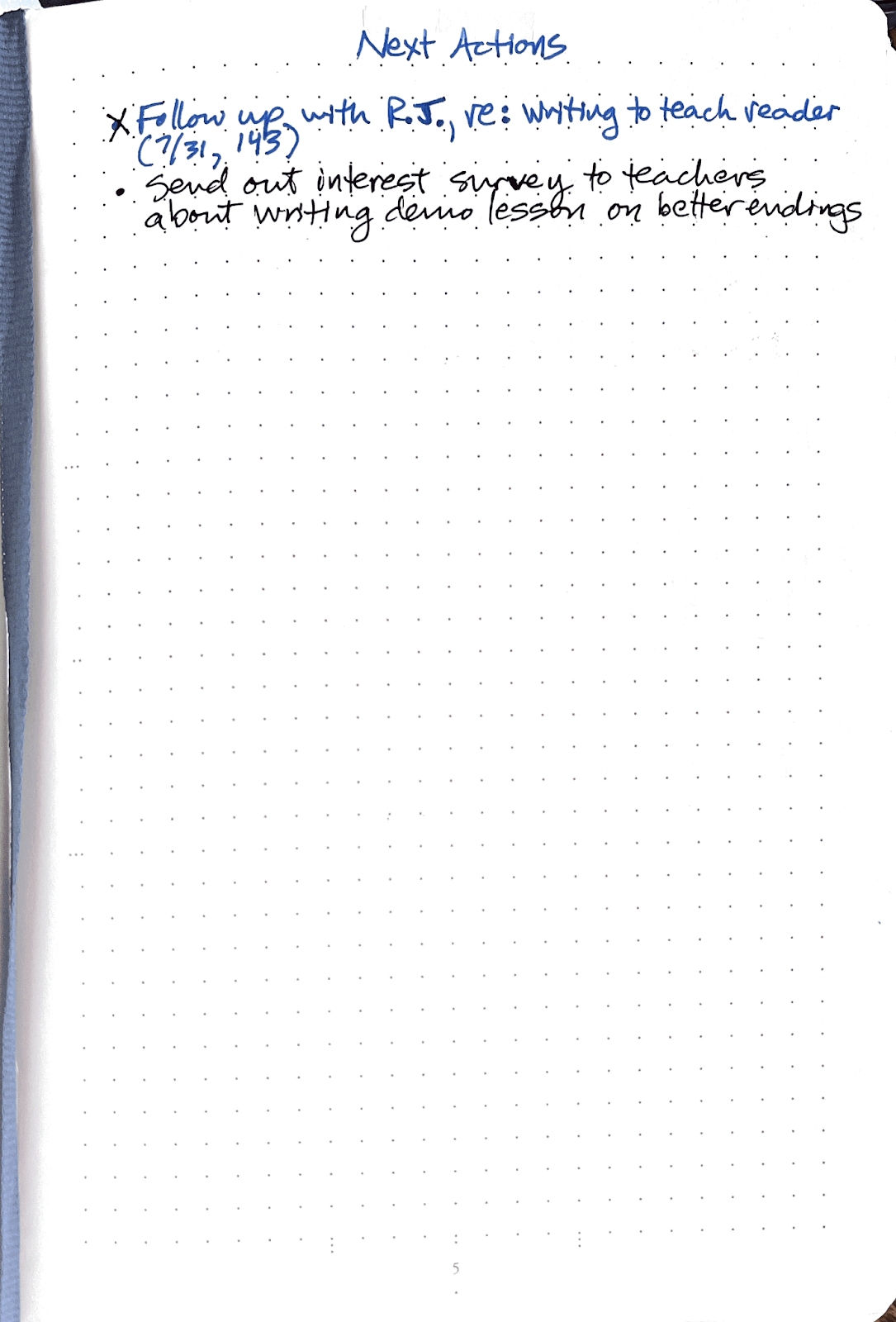
Conclusion: Form Follows Function
If you are on Instagram, you may have run across a dot journalist posting their artistic sketchnotes and renderings from their journals. Some people spend hours creating visuals and perfecting their calligraphy.
The coach’s notebook is not art. It is a tool that supports your practice. Mistakes are common. For example, you will notice that I forgot to document the date and page number for my most recent next action.
The question to ask with any tool, analog or digital, is Does it serve my needs, or am I serving the tool? With a coach’s notebook, form follows function. That function is supporting teaching and learning, at the individual and organizational levels.


